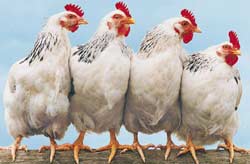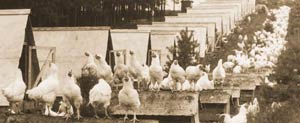



Fifty Years of Layer Breeding in in Cuxhaven
This year, Lohmann Tierzucht celebrated its 50th anniversary. This article, published in the company's Poultry News, outlines the organisation's history and achievements so far.In 1959, the first 'HNL Nick Chick' chicks hatched in Cuxhaven on the basis of a licence agreement between H&N and Lohmann and were distributed to progressive multipliers. At that time, nobody could imagine that Lohmann Tierzucht would advance to become a market leader worldwide as primary breeder of laying hens and to make history within the following 50 years.

The licence agreement included important conditions for this development. Above all, the faith that the licensor H&N had in Lohmann, combined with the transfer of the entire know-how of modern layer breeding and marketing under the name of HNL (Heisdorf & Nelson – Lohmann).
Starting with a line cross which had established its superiority in the USA, the breeding goals were adapted to preferences in the licensed territory and the breeding programmes were further developed during the time of the licence agreement.
When the licence agreement expired in 1978, Lohmann acquired the pure lines and expanded the breeding activities to compete in the global market for parent stock of white and brown layer hybrids.
In order to remain successful during such a long period of time and to gain market shares, Lohmann had to adapt breeding goals and focus of selection to the changing requirements of the respective markets and to improve procedures of performance testing and estimation of breeding values.
Continuous Adaptation
In retrospect, the development of Lohmann Tierzucht may be divided into five decades. During the first decade from 1959 until 1969 the breeding programme for 'HNL Nick Chick' layers in Cuxhaven was still a copy of the breeding programmes of H&N in the USA – a perfect example for the 'reciprocal recurrent selection' (RRS). Selected males and females of pure lines with proven combining ability were mated in pedigree to produce cross-line daughters for performance testing and subsequently switch-mated to produce pure-line progeny to be selected on the basis of short-term records of their cross-line half-sisters.
In contrast to the USA, the German egg market required a higher egg weight. Parent performance was poor compared with today's standards but that was accepted as the price to be paid for the best possible performance of the commercial layer.
Two Strategies against Marek's Disease
In the 1960s there were different opinions regarding the increasing risk of Marek's disease in some countries. H&N in the USA decided to include Marek's resistance in their selection index as additional characteristic. Max von Krosigk, responsible for the HNL breeding programme at the time, decided to split the lines in Cuxhaven. Selection of the main lines continued without testing for Marek's resistance, assuming that the problem would be solved by vaccination before resistant lines could be developed by breeding. At the same time, sub-lines were selected only on Marek's resistance in order to achieve quick results regarding this characteristic.
During the second decade from 1969 until 1979, a comprehensive analysis of genetic parameters of all important characteristics took center stage. As a result, Lohmann introduced new routines for performance testing.
First, egg production was recorded in four-week periods in order to analyse genetic parameters for sexual maturity and early production, peak rate of lay and persistency. That was the beginning of our focus on persistency of egg production, which has meanwhile been further improved.
To improve shell quality more effectively, Lohmann changed from specific weight to shell breaking strength, with emphasis on persistent shell quality in a longer production period.

below:Floor management of layers in a modern multiple tier system

Genetic Parameters Analysed
Then purebred and crossbred progeny of the same selected sires were reproduced simultaneously by means of artificial insemination in order to test them under identical conditions and estimate genetic correlations between purebred and crossbred performance and heterosis effects.
Based on these parameters, it was then decided to try combining crossline with pureline records in breeding value estimation. Subsequently, Lohmann changed to combined selection (mRRS) and thus improved the performance of pure breeds and parent stock substantially without sacrificing productivity of the commercial hybrids.
Finally, since the mid-1970s, individual feed consumption has been recorded, enabling Lohmann geneticists to select directly on egg income minus feed cost. With this trait, the appetite was optimised systematically instead of aiming at improved feed conversion ratio by minimising body weight and maintenance requirements.
During the third decade from 1979 until 1989, the focus was to breed for the Asian part of the world market. At the same time, the trend to brown eggs in Europe became more important. After disappointing early field results with experimental crosses, a new line combination enabled Lohmann to catch up with leading competitors.
Lohmann Brown Captures the Market
The list of 'most wanted' genetic characteristics was similar to those for our white-egg layer LSL: many saleable eggs during a typical production period, egg weight according to market preferences and efficient feed conversion. Moreover, egg shell colour should be uniform and attractive dark brown. With all these criteria Lohmann Brown soon achieved a good reputation.
As a result of the growing demand for brown-egg layers, more and more franchise hatcheries asked for feather-sexable white-egg layers. Lohmann introduced the gene for slow feathering from an experimental line into the LSL female parent line and reached the same performance level as the vent-sexing LSL variety before it was introduced in the market after 10 generations of development. An additional benefit of developing the feather-sexable LSL was that all lines in the Lohmann breeding programme had to be tested free of leukosis virus.
During the fourth decade from 1989 until 1999, layer breeders were increasingly confronted with animal welfare regulations. The general ban on conventional laying batteries in the EU beginning in 2012 and the existing or expected ban on beak trimming in several countries increase the risk of losses due to feather pecking or cannibalism, especially for brown-egg layers.
Similar to observations around 1970 when HNL layers performed better in German random sample tests under floor management conditions than in cages, the company observes a similar adaptability to non-cage management for LSL hens today.
Product Range Extended
In order to further reduce the risks of egg production in alternative management systems, all Lohmann lines are selected not only against feather pecking and cannibalism, but also for other behavior characteristics such as nest acceptance and usage of free-range.
During the most recent decade from 1999 until 2009, the product range was extended to meet specific customer demands as precisely as possible. Between LSL, LB, Silver, Tradition and Sandy for white, brown and tinted eggs, and Lite, Classic and Extra for different average egg size, franchise hatcheries can choose from about ten line combinations.
Marker Assisted Selection
As a first significant result of applied molecular genetics, Lohmann Tierzucht in cooperation with scientific institutes in Finland and Germany could isolate the gene responsible for the fishy taste sometimes observed in brown eggs. Meanwhile, all brown-egg lines of Lohmann are free from this defect.
Marker assisted selection advanced from the stage of basic research to application in product improvement for other characteristics too. Besides conventional performance testing for quantitative and qualitative characteristics, genomic analysis provides data for every breeding animal for more exact selection, thus increasing the accuracy of selection genetic progress.
Three Pillars of Success
The success story of Lohmann Tierzucht during the first 50 years of its history is based on three pillars: consistent application of latest genetic information and technology, optimised disease prophylaxis and – last but not least – true partnership with sophisticated customers whose demands are realised at an early stage and taken seriously.
Further Reading
| - | Go to our previous news item on this story by clicking here. |
December 2009








